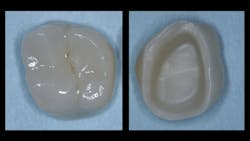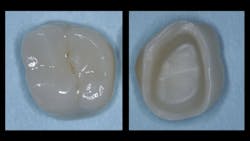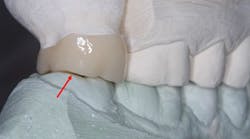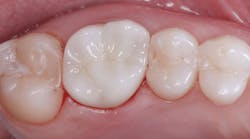Living with the zirconia crown generation
Each month, Dr. Gordon Christensen answers a question from readers about everyday dentistry.
Q: I’ve placed many zirconia crowns. Their characteristics are significantly different from porcelain-fused-to-metal (PFM) or cast-gold alloy crowns. Some aspects are better, but most are not as acceptable. Please share some suggestions about how to cope with these challenges.
A: We have been working with full-zirconia crowns for more than 10 years both clinically and in sophisticated in vivo research. Here are my observations based on the good and the questionable characteristics of full-zirconia (monolithic) crowns (figure 1).
Seating the crowns
As is becoming more well-known among dentists, if you send an analog impression to most labs, they scan your impression, reducing the accuracy that was present with the elastomer impression. Most crown impressions are now scanned in one of three ways: scan the prep in the mouth, scan the elastomer impression, or scan a poured die of the prep. The result is almost all tooth preparations are now scanned with various levels of inaccuracy.
Zirconia crowns are very easy to seat. I often hear praise from apparently unknowing practitioners who have concluded that the easy seating is related to the scan accuracy and the excellent crown fit. The optimistic advertising of most current scanner companies promotes accuracy of digital impressions.
Unfortunately, this is an exaggeration. The easy seating of zirconia crowns is related to a significant amount of spacing of the die. Is spacing the die bad? No, it has always been done but to a much more conservative level. In the analog past, the spacing of a stone die was about the thickness of one coat of lacquer (model airplane dope), which is about half the thickness of a human hair. The lacquer was not placed over the crown margin. Currently, when a computer spaces the dies, the spacing is thicker than in the past, and it goes over the crown margin, causing the tooth-crown juncture to be significantly more open.
Fit of zirconia crowns
Current scanner accuracy is not equal to vinyl or polyether elastomers. However, scanners are getting better, and AI will undoubtedly speed the needed improvement. They are rapidly becoming the future. I predict that it will take about five more years to see this improvement.
Currently, the zirconia crown margins are open far more than they were with cast-gold alloy crowns. The wide margin opening demands cariostatic cement for optimum potential longevity. Use a resin-modified glass ionomer cement (RelyX Luting from Solventum [3M]), or a conventional glass ionomer (FujiCEM Evolve from GC, or others). If using conventional glass ionomer, it is necessary to desensitize and disinfect the prep at the seating appointment with a glutaraldehyde solution to obturate the dentinal tubules (Microprime from Zest, Gluma from Kulzer, or others). The in vivo research available from Clinicians Report Foundation shows this desensitization requires two one-minute applications.
Zirconia crown occlusion
Technicians adjust the easily shaped presintered zirconia, providing the desired crown anatomy, but the various types of zirconia are strong but difficult to adjust when sintered.
Most dental laboratories space the occlusion short of opposing tooth contact by 300–500 microns (1/3 to 1/2 mm). Undoubtedly, you have noticed zirconia crowns are not in occlusal contact when you seat them.
You have probably also noticed the overall crown anatomy may or may not match the tooth anatomy on the other side of the arch. Why? The anatomy has been selected by the technician from a virtual tooth anatomy library. Therefore, due to occlusal spacing and the random generic crown anatomy, the occlusion of the opposing tooth and the restored tooth require months to extrude into contact. They may or may not occlude in the normal relationship you expected in the past before the digital involvement with crowns began. I am hopeful that AI will assist in developing the ability to have the crown anatomy and occlusion relate to the patient’s actual anatomy and occlusion.
Zirconia crown color
Having the original tooth color matched by a zirconia “puck” from which the zirconia crown is milled without some color modification is unlikely to happen. How is color changed to provide near-color-match with adjacent teeth? Internal color can be added at the presintering stage. Although this requires a technician with color education, this technique can provide near-optimum color and not require any external coloration. Some labs are placing a glaze on this internally pigmented type of crown after sintering, and some are not. The glaze lasts only a few years, and I prefer not to have it placed. The zirconia can be beautifully polished without placing a glaze.
Many labs are placing external stains and glaze to modify the crown color. This procedure was done with PFM crowns, and experienced dentists have seen this type of color modification soon wears or dissolves away, exposing the actual color of the zirconia. The degeneration of external coloration can be expected to happen during the first few years of clinical service.
At this stage of zirconia development, my personal preference is internal staining of the zirconia at the presintered stage. This type of color modification will not change during service, but it requires an experienced, educated technician and potentially higher lab cost.
Technician challenges
There are technicians, and there are “technicians.” The same is true for dentists. All dental clinical procedures require attention to detail, significant time, magnification, and an attitude demanding the production of an excellent result. Unfortunately, not all technicians or dentists can produce that same excellent result every time (figure 2).
I am a surgical prosthodontist, and I was a dental lab technician in my analog past. I have made many restorations myself. Unfortunately, in the current digital era, most dentists do not have the opportunity to combine laboratory knowledge and clinical needs. Here are my candid observations of some of the challenges with numerous zirconia crowns coming from different laboratories and dentists during our in vitro research on zirconia. I suggest you meet with your technician to reduce the challenges I present below. They are dentist and technician issues and require joint communication on the part of both:
- Reduce occlusion spacing to the thickness of a human hair (about 50 microns). This allows a shorter extrusion time and less hazard to adjacent teeth, but it may result in slight adjustment of the crown or opposing teeth at seating.
- When seating, adjust the occlusion of the teeth adjacent to the new crown to avoid overloading them while the teeth extrude.
- Set the computer to make the contact area slightly tight (about 50 microns). This allows the tech or dentist to smooth the contact area and eliminate the concave dents on the contact areas.
- If a patient has been previously treated for periodontal disease, make contacts tighter than normal, because the teeth move during chewing and food collects in the opening.
- Do not leave a right angle of zirconia at the coronal entry to the contact area. The entry should be slightly rounded to allow easy flossing.
- Make contact areas broad, smooth, and flat. Do not allow concave indentations on the contact areas, which are reservoirs for microorganisms and new caries on the adjacent tooth. Be sure no milling lines are left on the contact areas.
- Match the facial and lingual contour of the crown with the other teeth.
- Match the crown to the occlusal anatomy of the other teeth.
- Make the occlusal surface especially smooth and polished, or food will collect on that surface.
- Learn and use the internal zirconia coloration technique. Get color as close as possible.
- Avoid glaze if possible.
- Use a cariostatic cement!
Summary
Zirconia crowns can be beautiful, strong, and long-lasting if their limitations are known by both dentists and lab techs, and compensation is made for them.
Editor's note: This article appeared in the May 2025 print edition of Dental Economics magazine. Dentists in North America are eligible for a complimentary print subscription. Sign up here.
About the Author

Gordon J. Christensen, DDS, PhD, MSD
Gordon J. Christensen, DDS, PhD, MSD, is founder and CEO of Practical Clinical Courses and cofounder of Clinicians Report. His wife, Rella Christensen, PhD, is the cofounder. PCC is an international dental continuing education organization founded in 1981. Dr. Christensen is a practicing prosthodontist in Provo, Utah.




